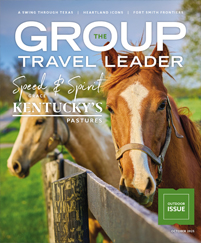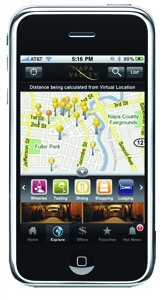
Courtesy Napa Valley Destination Council
The next generation of online travel marketing has arrived, and it goes beyond static informational Web sites to include mobile phone applications, e-mail blitzes, social networking strategies and interactive Web pages.
The past several years have brought the advent of Web 2.0, a new set of trends and technologies that have made the Internet a more social, interactive and media-rich experience. Just as convention and visitors bureaus (CVBs) embraced the Web 10 years ago as a new marketing tool, today they are updating their digital strategies with an array of these new capabilities to make connection and planning easier for travelers.
Today’s group leaders can find information and even build customized itineraries on a number of CVB Web sites. And the interaction continues with proprietary Web pages and on social networking sites, e-mail campaigns and iPhone applications.
Interest lists
In the Quad Cities along the Mississippi River in Illinois and Iowa, the local CVB has launched a new iteration of its Web site, www.visitquadcities.com, that includes customization tools for group travel planners.
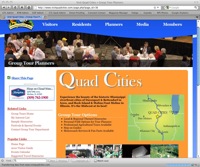 “We do an annual site review to make sure we’re keeping up with changing trends and technology,” said Charlotte Morrison, vice president of marketing at the Quad Cities Convention and Visitors Bureau. “The big new thing we added to the site this year is the group tour planner section.”
“We do an annual site review to make sure we’re keeping up with changing trends and technology,” said Charlotte Morrison, vice president of marketing at the Quad Cities Convention and Visitors Bureau. “The big new thing we added to the site this year is the group tour planner section.”
Though the Quad Cities site had previously contained sample itineraries for tour operators and group leaders, the CVB wanted to give planners access to all of the different attractions and events in the area. So it created a new tool that allows planners to browse through all of the area’s offerings and build customized itineraries based on what they like.
“One of the newest features is called ‘My Interest List,'” said Dan Gleason, the CVB’s group sales manager. “We have descriptions of area attractions and some of our themed itineraries. They can compile a list of what they like, and then it is sent to me so I can contact them and help to set up a customized itinerary to meet their needs.”
Gleason said he receives several interest list submissions every week from tour operators and group leaders, a number with which he is happy. He expects traffic to continue to pick up throughout this year as people plan tours for 2011.
“It was very well received during my trade shows at NTA [National Tour Association] and ABA [American Bus Association,” he said. “Planners really feel like it’s a great tool that they’ll be able to use in the future.”
Instant itineraries
In North Carolina, the Fayetteville Area Convention and Visitors Bureau has also created an itinerary builder for its site, www.visitfayettevillenc.com. The tool, called “Customize It,” allows individuals or groups to build their own travel itineraries.
“People can go in and pick out the options of things to see and do, where to stay, where to eat, and customize their own trip,” said CEO Jon Meroski. “The neat thing is that once it’s customized, you can burn it to a CD, and it becomes a self-guided audio tour.”
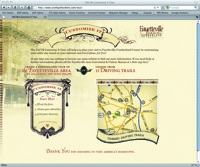 Users can choose between customizing their tours by looking at attractions and accommodations listings or basing their plans on one of 11 cultural heritage trails that the CVB has identified throughout the city and county. Creating the trails helped the staff organize a wide array of offerings, making it easier for visitors to find those attractions that best fit their curiosities.
Users can choose between customizing their tours by looking at attractions and accommodations listings or basing their plans on one of 11 cultural heritage trails that the CVB has identified throughout the city and county. Creating the trails helped the staff organize a wide array of offerings, making it easier for visitors to find those attractions that best fit their curiosities.
“It allows us to put 500 to 600 attractions and things to do under categories for people who want to participate in something by interest,” Meroski said. “While people like visitor guides and need them as a resource, we took our Web site and made it more personal. It allows us to get very detailed into the user experience.”
Since launching these features of the site, the CVB has found that a high percentage of visitors to their site use the planning tools and download customized itineraries. The tools also help to increase the average amount of time that users spend on the site, Meroski said.
iPhone application
One of the biggest innovations in recent years has been the development of “smartphone” technology, which allows users to view Web sites and run third-party programs on their mobile phones. The Napa Valley Destination Council (www.legendarynapavalley.com) in California is creating an application for the popular iPhone to give visitors handheld information about their destination.
“Our iPhone app will have all of the same things that are on our Web site,” said president Clay Gregory. “Every visitor-serving business in Napa Valley will be listed, whether they’re members of our CVB or not. We want it to be the most rich and complete guide to the Napa Valley.”
Users of iPhones will be able to access visitor information from this customized program on their phones without having to open a separate Web browser. Google Maps will also be integrated into the application so that users can see the specific location of a restaurant or attraction and then get directions to that spot from their current location.
The mobile phone application also creates the capability for location-based marketing, which would target people already on the ground in the destination.
“If a restaurant has a winemaker dinner on a Thursday night and has five seats available that morning, they’ll be able to send out a special offer to people who are in Napa Valley and let them reserve a spot in the restaurant for that very evening,” Gregory said.
The iPhone application is aimed at reaching well-educated travelers in their 20s and 30s, a demographic that is already Napa Valley’s second-strongest market segment.
E-mail blitz
Many online marking experts believe that e-mail is still the best electronic means of reaching customers. In New York, the Westchester County Office of Tourism (www.westchestertourism.com) uses a variety of e-mail campaigns to reach both individual travelers and group travel planners.
“We started doing a special e-newsletter for groups in the last 12 to 24 months,” said director Kim Sinistore. “We established e-mail lists from our trade shows, such as ABA, NTA or any show that will deal with the group market. We try to send out a quarterly newsletter that will give them events, activities or promotions that might entice them to look at Westchester.”
Sinistore said that quarterly seems to be the best frequency for reaching the group tour market. From the several thousand tour operators to whom she sends the e-mails, she said she has seen increased interest in the destination.
“I’m seeing some more bookings, and I think it’s helped in awareness, because we’re getting more calls and e-mails,” she said. “And I saw an increase in the number of appointments I had at ABA this year.”
The Office of Tourism also sends out a monthly e-mail blitz to individual travelers with updates and offers of a more timely nature.
Social media
One of the hallmarks of Web 2.0 is social networking, which allows users of a Web site to connect and interact with one another. Positively Cleveland uses a variety of social networking services to promote its city, including a Facebook page dedicated to group travelers.
“We have a Facebook fan page just for group and student tour planners,” said Samantha Fryberger, director of communications at the CVB. “There are certain things that a group needs that an individual traveler doesn’t. You need group-friendly hotels and restaurants, so we separated our fan pages for meeting planners and group tour operators.”
Positively Cleveland allows all its members to submit information to be posted on Facebook and other social networking sites. The organization has a social-media specialist on staff and is also helping to teach its members how to use social tools for themselves.
“We’ve had several training sessions so that we can answer their questions about how to use social media,” Fryberger said. “It’s a free session just to help them get up to speed.”
The CVB has integrated social network sharing tools on its Web site, www.positivelycleveland.com, allowing users to post information from the site directly onto its Facebook, Twitter and other social networking accounts. The CVB has also integrated reviews from TripAdvisor, a social travel review site, onto its Web page.
“We don’t screen the reviews — we’re really giving the whole story about everything that comes up,” said vice president of marketing Tamera Brown. “By us not screening those things, people will believe the positive stuff much more readily.”
Locals pitch in
Locals can help CVBs market their destinations to visitors online as well. Visit Eau Claire’s Travel Advisor Program recruits groups of residents to blog about spots around town, with positive results.
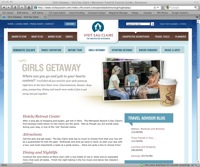 “The concept was to find people locally that fit different lifestyles, like girlfriends getaways,” said executive director Linda John. “We wanted people that live here to go out and experience the area as if they were visitors. We reimburse them for their expenses, and then their responsibility is to write about it on our Web site.”
“The concept was to find people locally that fit different lifestyles, like girlfriends getaways,” said executive director Linda John. “We wanted people that live here to go out and experience the area as if they were visitors. We reimburse them for their expenses, and then their responsibility is to write about it on our Web site.”
Though the initiative was intended to reach individual travelers, one of the blogs caught the eye of a planner for Girltime Getaways, a tour operator in Minnesota. As a result, the operator brought a group of 46 women to the Wisconsin town for a two-day visit.
John said that the next step of the Travel Advisor Program is to add video blogs and to recruit more locals to write about their favorite places without offering reimbursement. She hopes to have monthly blog updates posted in each of seven different lifestyle categories at www.visiteauclaire.com.
“People think it’s a neat concept and want to be a part of it,” she said. “We’re not going to tell them where to go, and we don’t edit their comments or blogs. Just by reading it, people can tell that these aren’t paid writers, and potential visitors can really identify with it.”







